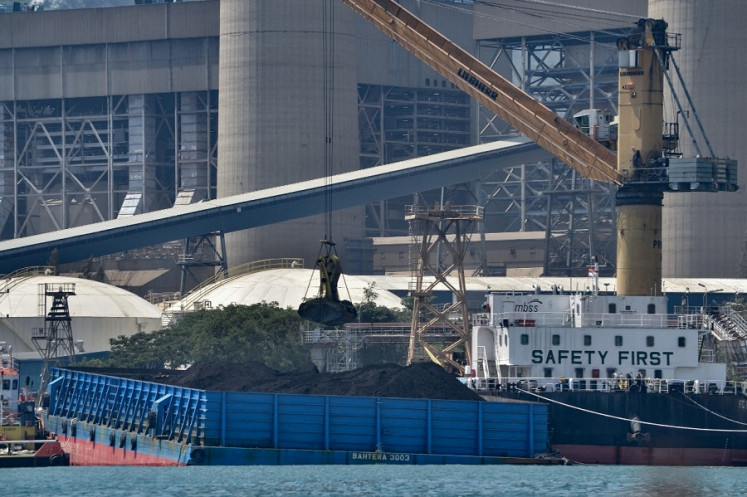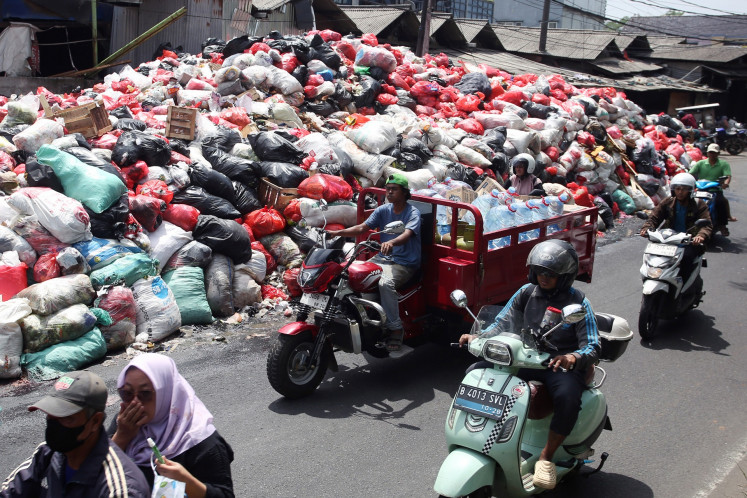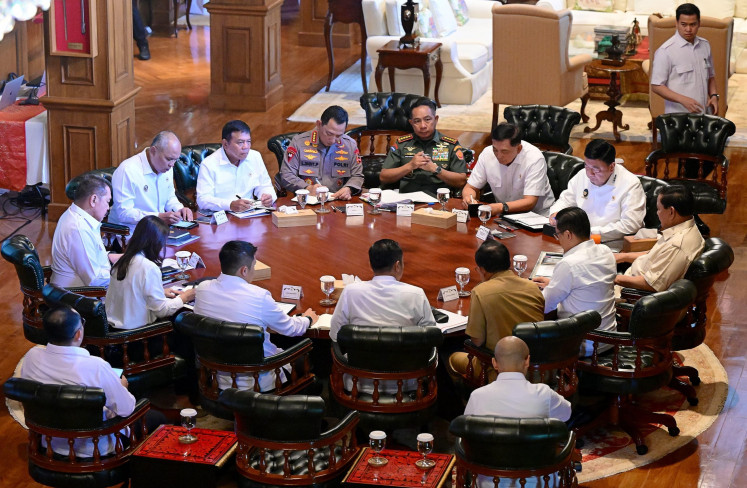Popular Reads
Top Results
Can't find what you're looking for?
View all search resultsPopular Reads
Top Results
Can't find what you're looking for?
View all search resultsSuralaya coal plant under fire for expansion project
The Suralaya power plant complex in Cilegon, around 100 kilometers west of Jakarta, is presently the largest such facility in Southeast Asia. The complex currently has eight power generation units (PGUs) with a total output capacity of 4,025 megawatts (MW).
Change text size
Gift Premium Articles
to Anyone
R
esidents of Cilegon, Banten province, have accused the World Bank Group of indirectly financing a project to expand a massive coal-fired power plant (PLTU) in Suralaya village, arguing the expanded plant would negatively affect their health and livelihood, environmental groups said on Thursday.
In a complaint lodged with the World Bank, the residents have alleged that its member International Finance Corporation (IFC) had made an equity investment in a bank that is financing the Suralaya PLTU expansion project, but they do not allege that the investment was used to fund the project.
The Suralaya power plant complex in Cilegon, around 100 kilometers west of Jakarta, is presently the largest such facility in Southeast Asia. The complex currently has eight power generation units (PGUs) with a total output capacity of 4,025 megawatts (MW), and the plan to add two PGUs, Java 9 and 10, will increase output by 2,000 MW.
The expansion project “will devastate local communities and tip the world closer to a climate catastrophe, to which Indonesia and its citizens are uniquely susceptible,” Novita Indri, energy activist at the Trend Asia, said in a statement.
Trend Asia is an Indonesian foundation that is coordinating with Inclusive Development International (IDI), a human rights group based in the United States, in assisting the residents with their formal complaint.
The expansion project is being developed by PT Indo Raya Tenaga, a joint venture between state-owned electricity company PLN and South Korean heavy industry firm Doosan Enerbility.
Read also: Govt shuts down Suralaya power plant in bid to reduce air pollution
Other financiers of the project include Hana Bank Indonesia, which received a US$15 million equity investment from the IFC in 2019, according to the complaint.
That investment is verified by a document on the IFC website.
The complaint elaborates that the IFC knew about the plan to expand the Suralaya plant with the addition of the Java 9 and 10 PGUs, because Hana Bank provided funds totaling $56 million in July 2020 to developer Indo Raya Tenaga.
While the residents did not allege that the IFC’s equity investment in Hana Bank contributed to the $56 million fund for the Suralaya expansion project, their complaint said the IFC should in no way be connected to any coal projects in Indonesia.
“The complainants want to ensure the closure of any remaining loopholes that would allow the IFC to indirectly finance a new coal project in the future via [its] financial intermediary clients,” stated the complaint filed with the World Bank.
In March, the IFC updated its policy for financial clients such as banks to end any new investments in coal. The previous policy only required clients to reduce funding coal by half by 2025 and to zero by 2030.
The World Bank has vowed to align its operations with the 2015 Paris Agreement on climate change and to help countries transition to cleaner energy sources. Critics say, however, that the world’s largest development bank is still supporting coal projects through financial intermediaries and is not doing enough to ensure clients’ compliance with its environmental and social standards.
Lestari Boediono Qureshi, the World Bank’s acting director for Indonesia and Timor-Leste, declined to comment on the complaint.
The IFC, Hana Bank and the Energy and Mineral Resources Ministry did not reply immediately to requests for comment, reported BenarNews.
Coal is unloaded from a barge on Sept. 22, 2021 at the Suralaya coal-fired power plant in Cilegon, Banten. (AFP/Ronald Siagian)Environmental degradation
The construction of the Java 9 and 10 PGUs was “totally unwarranted” because local electricity needs were already being met and the Java-Bali electricity grid had reached oversupply, said Novita of the IDI.
The Suralaya power plant, which has been operating since 1984, has been linked to air pollution, water contamination and soil degradation in Cilegon.
As a result, the area’s farming and fishing industries have become increasingly unviable due to the impacts of environmental degradation on soil and marine life, according to the residents’ complaint.
Read also: Silent, invisible danger on Cirebon coast
In addition, families had been forcibly evicted to make way for the new plants and had not received adequate compensation, while the last remaining beach in the area had been destroyed, greatly impacting tourism and local businesses, said the complaint.
A study by the Centre for Research on Energy and Clean Air (CREA) released on Tuesday found that the Suralaya power plant complex had led to health problems at an annual cost of $1 billion.
The Suralaya PLTU also contributes to smog and haze in Jakarta, which topped the list of the world’s most polluted cities in August.
The expanded facility will only add to these woes, say environmental groups that are supporting the Cilegon residents’ complaint.
The IDI said that once completed, the new PGUs would emit an estimated 250 million metric tons of carbon dioxide over their 30-year lifespan, further contributing to global warming in Indonesia.
The archipelagic country is among those deemed most vulnerable to climate change.
Indo Raya Tenaga president director Peter Wijaya said last week that the Java 9 and 10 PGUs use hybrid technology, which made them more environmentally friendly, reported Investor Daily.
The new units would use a mix of 60 percent ammonia and green hydrogen and 40 percent coal to generate electricity, according to the business daily.
The Java 9 and 10 development project is slated for completion 2025 and is part of President Joko “Jokowi” Widodo’s ambitious plan to increase nationwide electricity capacity by 35 gigawatts by 2024.
However, as the electricity supply exceeded demand in Java, the government should focus more on improving distribution networks and expanding access to other regions, said Daymas Arangga, executive director of advocacy group Energy Watch.
“Companies that head to [other] regions, for example, have difficulty building smelters because there is no adequate electricity supply,” Daymas told BenarNews.
Coal, the dirtiest fossil fuel, generates 65 percent of energy needs in Indonesia, the largest and most populous country in Southeast Asia.
The country is ranked eighth among the world’s biggest polluters, contributing 2 percent of global greenhouse gas emissions, according to the World Resources Institute.
Read also: Some coal power plants may be labeled ‘green’ in revised classification
The country’s energy sector accounts for nearly 50 percent of overall emissions, while motor vehicle emissions contribute around 20 percent, according to Industry Ministry data.
Indonesia aims to cap emissions from the energy industry at 290 megatons of carbon by 2030, a decrease from its previous cap of 357 megatons. It has also agreed to accelerate renewables development to reach at least 34 percent of the country’s energy mix, also by 2030.
Last year, the government signed a Just Energy Transition Partnership with several foreign donor countries and organizations that aims to provide $20 billion in funding to help Indonesia shift away from coal and other fossil fuels.












